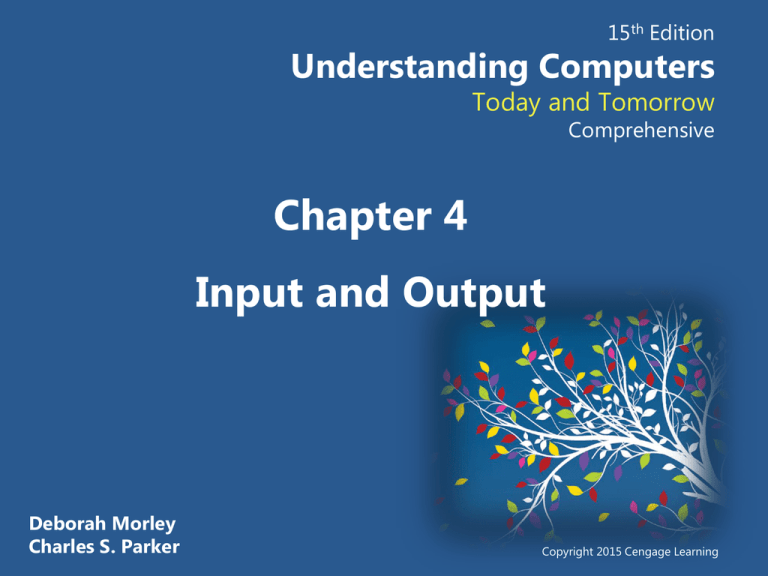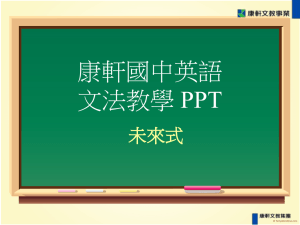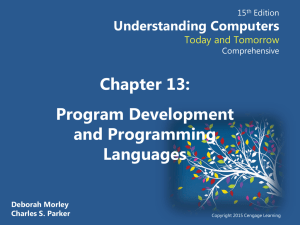morley15e__ppt_ch04 REV
advertisement

15th Edition Understanding Computers Today and Tomorrow Comprehensive Chapter 4 Input and Output Deborah Morley Charles S. Parker Copyright 2015 Cengage Learning Learning Objectives 1. Explain the purpose of a computer keyboard and the types of keyboards widely used today. 2. List several different pointing devices and describe their functions. 3. Describe the purposes of scanners and readers and list some types of scanners and readers in use today. 4. Explain what digital cameras are and how they are used today. 5. Understand the devices that can be used for audio input. Understanding Computers: Today and Tomorrow, 15th Edition 2 Learning Objectives 6. Describe the characteristics of a display device and explain some of the technologies used to display images. 7. List several types of printers and explain their functions. 8. Identify the hardware devices typically used for audio output. Understanding Computers: Today and Tomorrow, 15th Edition 3 Overview • This chapter covers: – The most common input devices – Hardware designed for capturing data in electronic form – Audio input – Types of display devices and how they work – Types of printers and how they work – Audio output devices Understanding Computers: Today and Tomorrow, 15th Edition 4 Keyboards • An input device used to enter characters at the location marked by the insertion point or cursor – Can be wired or wireless – Typically contains: • Standard alphanumeric keys • Numeric keypad • Function keys • Delete and Backspace keys • Control and Alternate keys • Arrow directional keys and special keys Understanding Computers: Today and Tomorrow, 15th Edition 5 Keyboards Understanding Computers: Today and Tomorrow, 15th Edition 6 Keyboards • Mobile devices often use: – Slide-out keyboard – Pen or touch input (on-screen keyboard) – Keyboard dock Understanding Computers: Today and Tomorrow, 15th Edition 7 Pointing and Touch Devices • Pointing devices are used to: – Select and manipulate objects – Input data – Issue commands to the computer • Common types of pointing devices: – Mouse – Pen/stylus – Devices that use touch input Understanding Computers: Today and Tomorrow, 15th Edition 8 Mice • Mouse – Common pointing device that the user slides along a flat surface to move a pointer around the screen and clicks its buttons to make selections – Older mechanical mice use a ball – Optical or laser mice track with light – Touch mice support two-dimensional gestures Understanding Computers: Today and Tomorrow, 15th Edition 9 Mice Understanding Computers: Today and Tomorrow, 15th Edition 10 Trend Box Perceptual Computing – Users control devices with 3D gestures, voice commands, and facial expressions – Noncontact system – Allows for full body input and input from a slight distance away Understanding Computers: Today and Tomorrow, 15th Edition 11 Pens/Styluses • Stylus – Pen-like device used to draw or write electronically on the screen – Also called digital pen, electronic pen, tablet pen – Pen input is being used for: • Photography, graphic design, animation • Industrial design, document processing, and healthcare applications • Navigating through a document • Issuing commands Understanding Computers: Today and Tomorrow, 15th Edition 12 Pens/Styluses – Pen-Based Computers and Mobile Devices • Pen input used with mobile devices and tablet computers – Used to input handwritten text and sketches and to manipulate objects – If handwriting recognition is used, written text can be converted to editable typed text Understanding Computers: Today and Tomorrow, 15th Edition 13 Pens/Styluses • Digital Writing Systems – Pen-based systems that capture handwritten input as it is being written – Requires special paper with a grid of dots – Handwritten input can be transferred to computer • Graphics Tablets – Pen tablets or digitizing devices – Flat, touch sensitive tablet typically connected to computer using a USB port Understanding Computers: Today and Tomorrow, 15th Edition 14 Pens/Styluses • Signature Capture Devices – Found at check out counters to record customer signatures Understanding Computers: Today and Tomorrow, 15th Edition 15 Touch Screens • Touch Screens – Display devices that are touched with the finger to select commands or otherwise provide input to the computer – Common on portable computers, smartphones, and other mobile devices – Multi-touch • Can recognize input from more than one finger at a time – Table PC • Large screen computer either built into a table or designed to be used on a table Understanding Computers: Today and Tomorrow, 15th Edition 16 Touch Screens Understanding Computers: Today and Tomorrow, 15th Edition 17 Other Pointing Devices • Gaming devices • Trackballs • Control buttons and wheels • Touch pads Understanding Computers: Today and Tomorrow, 15th Edition 18 Quick Quiz 1. An optical mouse is __________. a. the same as a wireless mouse b. a mouse that tracks movements with light instead of a ball c. a mouse that contains a scroll wheel on the top 2. True or False: With handwriting recognition, text is input as a graphical image so the text cannot later be edited as text. 3. An input device that looks like an upside-down mouse with the ball on top is a(n) __________. Answers: 1) b; 2) False; 3) trackball Understanding Computers: Today and Tomorrow, 15th Edition 19 How It Works Box Augmented Reality – Computer generated images are overlaid on top of realtime images – Today, most often with smartphones using camera input, location info, and other data – Displays appropriate information related to images captured by the smartphone Understanding Computers: Today and Tomorrow, 15th Edition 20 Scanners, Readers, and Digital Cameras • Source documents – Already exists in physical form (photographs, checks, or product label) • Source data automation – Captures data directly from a source document • Saves time • Increases accuracy • Utilizes scanning or reading devices Understanding Computers: Today and Tomorrow, 15th Edition 21 Scanners • Scanners (Optical Scanners) – Input devices that read printed text and graphics and transfers them to a computer in digital form – Data is typically input as a single image – Can scan photos, documents, images – Types of scanners • Flatbed • Portable • 3D • Receipt and business card scanners Understanding Computers: Today and Tomorrow, 15th Edition 22 Scanners Understanding Computers: Today and Tomorrow, 15th Edition 23 Scanners • Scanning Quality and Resolution – Quality of scanned images indicated by optical resolution • Measured in number of dots per inch (dpi) • Can often be specified when image is scanned • Can be changed when scanned image is edited – Higher resolution means better quality but larger file size Understanding Computers: Today and Tomorrow, 15th Edition 24 Readers • Barcode Readers – Input devices that read barcodes • Barcodes – Machine-readable codes that represent data as a set of bars – Common Types • Universal Product Code (UPC) • ISBN • DataBar • QR Codes Understanding Computers: Today and Tomorrow, 15th Edition 25 Readers Understanding Computers: Today and Tomorrow, 15th Edition 26 Readers Understanding Computers: Today and Tomorrow, 15th Edition 27 Readers • Radio Frequency Identification (RFID) Readers – Technology used to store and transmit data located in RFID tags – RFID tags contain tiny chips and radio antennas • Can be attached to objects • Read by RFID readers • Tags only need to be within range of the reader, rather than in the line of sight Understanding Computers: Today and Tomorrow, 15th Edition 28 Readers • Applications – Tracking inventory and assets – Electronic toll collection – Tracking patients in hospitals – Ticketing applications – Speeding up ID process of travelers at border crossings • Types of RFID Readers – Handheld, portal, and stationary • Slow to catch on in retail industry due to privacy and security issues Understanding Computers: Today and Tomorrow, 15th Edition 29 Readers Understanding Computers: Today and Tomorrow, 15th Edition 30 Readers • Optical Mark Readers (OMRs) – Input data from special forms to score or tally exams, questionnaires, ballots • Optical Character Recognition (OCR) Devices – OCR is the ability of a computer to recognize scanned text characters and convert them to electronic form as text, not images – OCR software is used to identify each character and convert it to editable text – Used to process turnaround documents like monthly bills Understanding Computers: Today and Tomorrow, 15th Edition 31 Readers • Magnetic Ink Character Recognition (MICR) Readers – Also called check scanners – Used primarily for banking – Read the special magnetic characters printed at the bottom of checks – High volume readers process deposited checks – Used to facilitate remote deposits and electronic check processing Understanding Computers: Today and Tomorrow, 15th Edition 32 Readers • Biometric Readers – Used to input biometric data such as an individual’s fingerprint or voice – Can be stand-alone or built into another piece of hardware – Most often used for access control, to authorize electronic payments, log on to secure Web sites Understanding Computers: Today and Tomorrow, 15th Edition 33 Technology and You Box Mobile Deposits – Mobile remote deposit capture – Transmit check information via smartphone app and camera – App optimizes the check front and back images and transmits images and deposit data to your bank Understanding Computers: Today and Tomorrow, 15th Edition 34 Digital Cameras • Digital Cameras – Take pictures and records them as digital images – Can either be still cameras or video cameras – Integrated into many portable computers and mobile phones • Digital Still Cameras – Primary appeal is that images are immediately available – Camera quality is measured in megapixels – Typically use flash memory for storage – Camera phones can be used to read barcodes, remotely deposit checks, etc. Understanding Computers: Today and Tomorrow, 15th Edition 35 Digital Cameras Understanding Computers: Today and Tomorrow, 15th Edition 36 Digital Cameras • Digital Video Cameras – Digital camcorders, PC video cameras (PC cams, webcams) – Built-in or stand alone – Store images on digital media (flash memory, DVDs, hard drives, etc.) • Applications – Surveillance video cameras – Video conferences and Webinars – Face recognition systems Understanding Computers: Today and Tomorrow, 15th Edition 37 Audio Input • Voice Input and Speech Recognition Systems – Audio Input • The process of entering audio data into the computer – Voice Input • Inputting spoken words and converting them to digital form via microphone or headset • Can be used for podcasts and with VoIP (Voice over IP) systems • Provides spoken instructions to computer when used with speech recognition systems Understanding Computers: Today and Tomorrow, 15th Edition 38 Audio Input Understanding Computers: Today and Tomorrow, 15th Edition 39 Audio Input • Music Input Systems – Used to input music • Existing music can be input using CDs or a Web download • For original compositions, microphones, keyboard controllers, and guitar controllers can be used to input music Understanding Computers: Today and Tomorrow, 15th Edition 40 Quick Quiz 1. Which of the following is used in conjunction with Scantron test forms, voting ballots, and other documents in which the selection is bubbled in? a. OCR b. MICR c. OMR 2. True or False: Flatbed scanners can be used to scan photos, as well as documents on conventional paper. 3. A voice input system requires software and a(n) __________ in order to input voice data or commands into a computer. Answers: 1) c; 2) True; 3) microphone Understanding Computers: Today and Tomorrow, 15th Edition 41 Display Devices • Display Device – Presents output visually on some type of screen – Monitor • Display device for a desktop computer – Display Screen • Screen built into a variety of devices – Notebook and other portable computers – Mobile phones and mobile devices – Handheld gaming devices, home entertainment devices, kitchen appliances – Digital photo frames, e-book readers, smart watches – Digital signage systems, digital billboards Understanding Computers: Today and Tomorrow, 15th Edition 42 Display Devices • Display Device Characteristics – Color vs. Monochrome Displays • Images are formed using pixels • Most displays today are color displays – CRT vs. Flat-Panel Displays • Cathode ray tube (CRT) displays: large, bulky, and heavy • Flat-panel displays: take up less desk space; use less power Understanding Computers: Today and Tomorrow, 15th Edition 43 Display Devices • Size and Aspect Ratio – Device size measured diagonally from corner to corner • Screen Resolution – Number of pixels used on a display determines resolution – Affects the amount of information that can be displayed on the screen at one time – Can be changed to match users’ preference Understanding Computers: Today and Tomorrow, 15th Edition 44 Display Devices • Video Adapters, Interfaces, and Ports – Video cards determine the graphic capabilities of a computer – VGA, DVI, and HDMI are the three most common interfaces to connect monitors to a computer – Ports exposed in the system unit cases are to connect monitors to computers • New option is to use USB ports Understanding Computers: Today and Tomorrow, 15th Edition 45 Display Devices • Wired vs. Wireless Displays – Wired display are physically connected to the system via a cable – Wireless displays connect using a wireless network connection (Wi-Fi, Bluetooth) • 2D vs. 3D Displays – Most displays are 2D – 3D displays use filters, prisms, and multiple lenses to create the 3D effects Understanding Computers: Today and Tomorrow, 15th Edition 46 Display Devices • Wearable Displays – Project images from a mobile device to a display screen built into glasses • Touch and Gesture Capabilities – Kiosks and portable gaming devices – Mobile phones and media tablets Understanding Computers: Today and Tomorrow, 15th Edition 47 Flat Panel Display Technologies • Liquid Crystal Displays (LCDs) – Use charged liquid crystals between sheets of glass or plastic – Requires backlighting • Light Emitting Diode (LED) Displays – Used in alarm clocks and Christmas lights – Currently used to backlight LCD panels Understanding Computers: Today and Tomorrow, 15th Edition 48 Flat Panel Display Technologies • Organic Light Emitting Diode (OLED) Displays – Use layers of organic material – Emit visible light when current is applied – Are thinner than LCDs – Have a wider viewing angle – Incorporated into many digital cameras, mobile phones, and portable digital media players Understanding Computers: Today and Tomorrow, 15th Edition 49 Flat Panel Display Technologies • Special Types of OLEDs – FOLED (Flexible OLED) • OLED displays built on flexible surfaces such as plastic or metallic foil – TOLED (Transparent OLED) • Displays are transparent • Emit light toward top and bottom of display surface – PHOLED (Phosphorescent OLED) • Process that results in much more conversion of electrical energy into light instead of heat Understanding Computers: Today and Tomorrow, 15th Edition 50 Flat Panel Display Technologies Understanding Computers: Today and Tomorrow, 15th Edition 51 Flat Panel Display Technologies – Interferometric Modulator (IMOD) Displays • Essentially a complex mirror that uses external light to display images • Designed initially for mobile phones and portable devices • Images are bright and clear, even in sunlight – Plasma Displays • Use layers of gas between two plates of glass • Being replaced by LCDs Understanding Computers: Today and Tomorrow, 15th Edition 52 Inside the Industry Box E-Paper – Used for e-readers and other devices – Easier to read in direct sunlight – Content can change wireless – Only uses power to change images, not maintain an image – Use electronic ink – Monochrome or color Understanding Computers: Today and Tomorrow, 15th Edition 53 Data and Multimedia Projectors • • • • • Display output from a computer to a wall or projection screen Found in classrooms and conference rooms Can be wireless or integrated into devices Some contain an iPod dock Pico projectors are pocket-size and connect mobile and portable devices • Hologram projectors used to display 3D images • 3D projectors are designed to project 3D images that are viewed with 3D glasses Understanding Computers: Today and Tomorrow, 15th Edition 54 Data and Multimedia Projectors Understanding Computers: Today and Tomorrow, 15th Edition 55 Printers • Printing Technology – Impact Printers (Dot Matrix) • Print mechanism strikes an inked ribbon to transfer ink to the paper • Used to produce multipart forms – Non-Impact Printers (Ink-Jet/Laser) • Use liquid ink or toner • Produce higher quality images • Much quieter than impact printers Understanding Computers: Today and Tomorrow, 15th Edition 56 Printers • Color vs. Black and White – Colors printers use magenta, cyan, yellow, and black ink • Print Resolution – Measured in dpi (dots per inch) – More dots per inch results in higher quality output – 300 dpi for general purpose printing; 1,200 dpi for photographs; 2,400 dpi for professional applications • Print Speed – Measured in pages per minute (PPM) – Range from about 15 to 65 ppm Understanding Computers: Today and Tomorrow, 15th Edition 57 Printers • Personal vs. Network Printers – Personal printers connect directly to a single computer – Network printers connect directly to a home or an office network; some can perform cloud printing – Connection Options • USB connection most common • Multifunction Capabilities – Copy, fax, scan, print – All-in-ones Understanding Computers: Today and Tomorrow, 15th Edition 58 Laser Printers • Use toner powder and technology similar to that of a photocopier to produce images on paper • The standard for business documents • Print one entire page at a time • Generally faster and have better quality output than ink-jet printers • Can be black and white or color • Common print resolution for laser printers is between 600 and 2,400 dpi • Use toner cartridges Understanding Computers: Today and Tomorrow, 15th Edition 59 Ink-Jet Printers • • • • • • • Sprays droplets of ink to produce images on paper Use ink cartridges Usually print in color Often the choice for home use Relatively inexpensive with good-quality output Print more slowly than laser printers Potential applications for the future – Dispensing liquid metal, aromas, computer chips and other circuitry, “printing” human tissue Understanding Computers: Today and Tomorrow, 15th Edition 60 Ink-Jet Printers Understanding Computers: Today and Tomorrow, 15th Edition 61 Special Purpose Printers • Barcode, label, and postage printers • Photo printers • Portable and integrated printers • Wide-format ink-jet printers • 3D printers Understanding Computers: Today and Tomorrow, 15th Edition 62 Audio Output • Audio Output – Voice, music, and other audible sounds – Common audio output devices • Computer speakers • Headphones and headsets • Earphones and earbuds Understanding Computers: Today and Tomorrow, 15th Edition 63 Quick Quiz 1. Which of the following types of display devices should have the largest footprint (the amount of room taken up on a desk)? a. CRT monitor b. OLED display c. LCD display 2. True or False: Laser printers can only print in black and white. 3. __________ printers form images with drops of liquid ink. Answers: 1) a; 2) False; 3) Ink-jet printers Understanding Computers: Today and Tomorrow, 15th Edition 64 Summary • • • • • • • Keyboards Pointing and Touch Devices Scanners, Readers, and Digital Cameras Audio Input Display Devices Printers Audio Output Understanding Computers: Today and Tomorrow, 15th Edition 65








